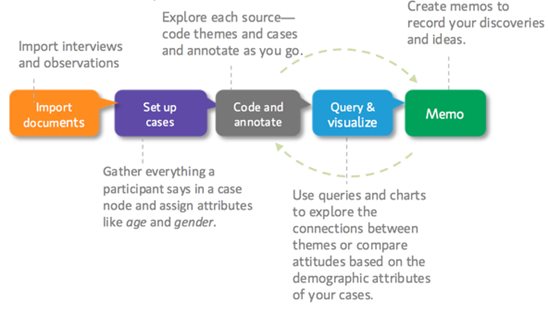
As the demand for deeper understanding and nuanced insights grows across sectors like education, business, healthcare, and government, the value of qualitative research skyrockets. Grasping the essence of qualitative research and harnessing the power of supporting technologies like a qualitative data analysis software can be a significant career accelerator.
What does 'qualitative' mean?
Qualitative research is exploratory in nature, focusing on understanding the reasons, opinions, and motivations behind human behavior. Unlike quantitative research, which deals with numbers and statistics, qualitative research delves into unstructured or non-numerical data. This includes data collection methods like interviews, focus groups, and open-ended survey responses. It's about exploring the 'how' and 'why' behind phenomena, whether it's evaluating government policies, studying cultural linguistics, or understanding consumer behavior.
Even if you're just reading journal articles, books, reports or blog posts (to get your head around a particular topic) - then you're doing qualitative research.
Learn more about using interview data in the article Thematic Analysis of Interview Data: 6 Ways NVivo Can Help and webinar Using NVivo with Institutional Data - Surveys, Interviews & Focus Groups.
How does it differ from quantitative research?
While quantitative research quantifies problems through statistical data, qualitative research enriches this understanding by exploring the qualitative aspects - the underlying reasons and motivations.
Quantitative analysis relies more heavily on statistics, math, and computational techniques. For example, a quantitative study might indicate that 50% of your customers are dissatisfied while a qualitative approach can help you to understand why.
Albert Einstein summed it up well: "Not everything that can be counted counts, and not everything that counts can be counted."
Nowadays, the mixed-method approach, which combines both qualitative and quantitative methods and various forms of data collection, is increasingly recognized for its comprehensive insights.
>> Watch NVivo 14: Mixed Methods Research with NVivo
How do you do qualitative research?
The qualitative research process involves sifting through various types of unstructured data (like text, video, audio, surveys, and social media) to identify themes, patterns, and correlations. They follow hunches, gather evidence, develop recommendations and present their findings in formats like a thesis, report, journal article or video documentary. The methods that qualitative researchers use can also vary. For example, a few qualitative research methods include content analysis, thematic analysis, and discourse analysis.
It's an engaging journey that can vary greatly depending on the researcher's methodology and objectives. There’s no one-size-fits-all process, making it a highly creative and personalized field.
So, while the term 'qualitative research' sounds a little dry, the journey can be “...intense, engaging, challenging, non-linear, contextualized, and highly variable.”
Learn more about the stages of labeling your qualitative data in the article Perfecting the Art of Qualitative Coding.

The Role of Technology in Qualitative Research:
Gone are the days when qualitative research was confined to manual notetaking. Modern researchers leverage tools like NVivo, a leading software for organizing, presenting, and analyzing qualitative data.
NVivo enhances the research process by offering efficient data management, advanced querying, autocoding for text analysis, and collaborative features – making it a vital tool for both students and professionals.
Learn more in the article What is Qualitative Data Analysis (QDA) Software?
Examples of Qualitative Research Projects Using NVivo
Here are two scenarios of how a researcher might use NVivo to support their research:
1. Evaluating Stakeholder Perceptions: Using NVivo, a researcher can analyze feedback from a community arts program to identify key themes and stakeholder sentiments.

2. Exploring Online Communication: NVivo assists in dissecting the language used in online communities, helping to understand social dynamics and communication patterns.

Each qualitative research project is unique, and NVivo is designed to accommodate this diversity. It provides a structured yet flexible approach to manage and interpret rich qualitative data effectively.
>> Discover more ways to use NVivo on our YouTube channel
ABOUT THE AUTHOR

Kath McNiff
Kath McNiff is on a mission to help researchers deliver robust, evidence-based results. If they’re drowning in a sea of data (or floods of tears) she wants to throw them an NVivo-shaped life raft. As an Online Community Manager at QSR, she knows that peers make the best teachers. So, through The NVivo Blog, Twitter and LinkedIn, she shares practical advice and connects researchers so they can help each other. When she’s not busy writing blog posts, swapping stories on social media or training the latest tribe of NVivo users, she can be found wrestling four feisty offspring for control of the remote.

